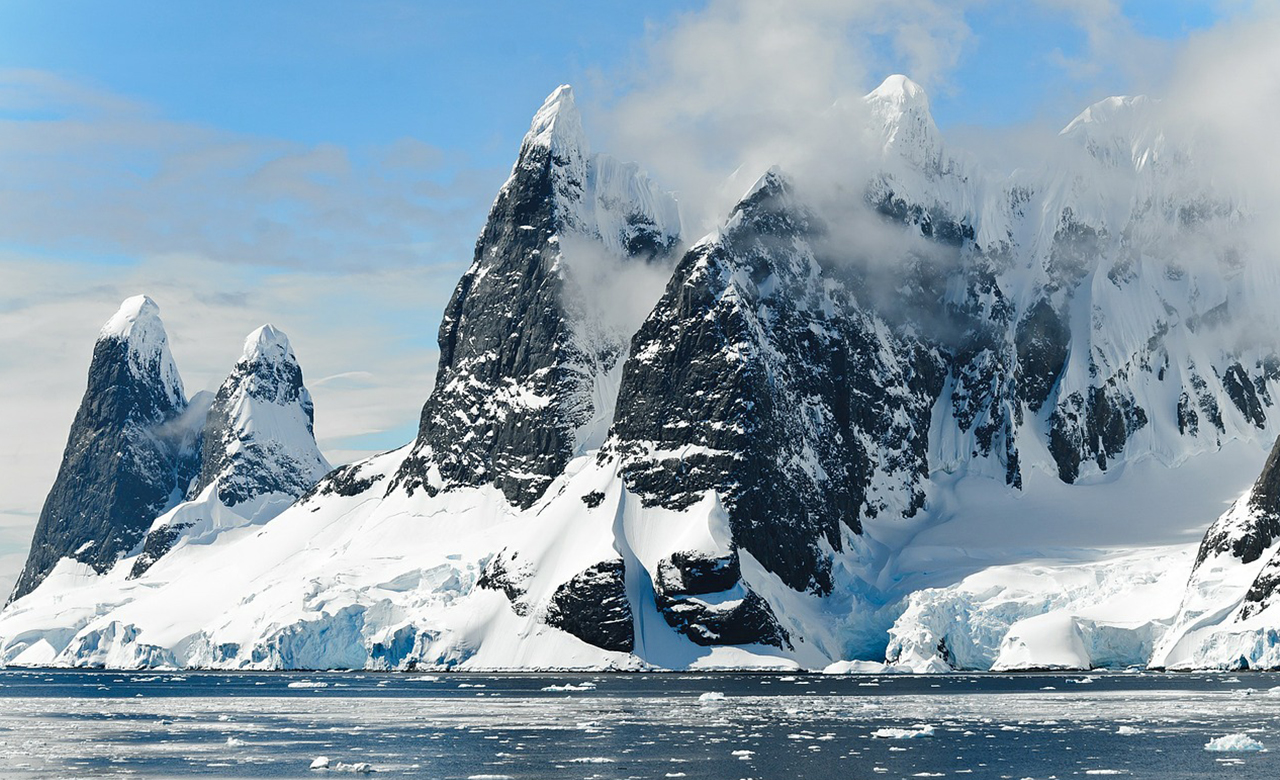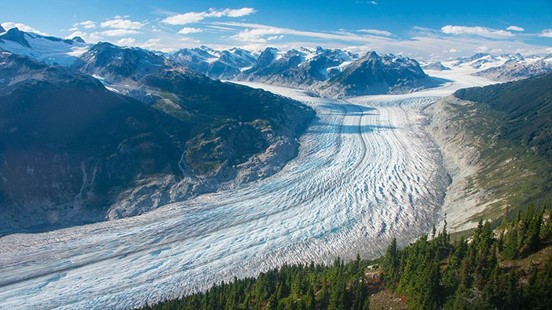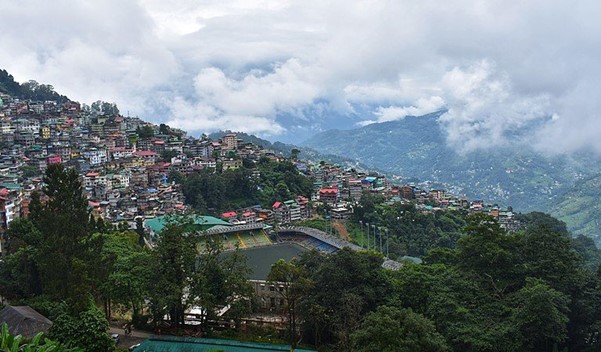
During the last 20 years, the pace of glacier melting has nearly doubled. According to the most comprehensive study of ice rivers, it contributes more to sea-level rise than Greenland or Antarctica.
Glacial Retreat – A Brief Assessment
An assessment of all ice streams(Figure 1) on the planet has suggested that meltwater has produced almost 270 billion tonnes of ice loss over the past two decades. With a 52Gt/year/decade acceleration, glaciers have lost about 280 gigatonnes of ice per year, equivalent to a 21% sea-level rise. This meltwater that flows from large glaciers spanning around 2,000 km in mountain ranges in South Asia is critical for the lives and livelihoods of the people downstream. Most of the glaciers in the region are thinning by about 40 to 60 cm per year, losing 8 billion tonnes of ice each year on average. As a result, changes in glacial mass balance disrupt water supplies for billions of people downstream – especially in a drought when meltwater becomes a critical source. The significance of an accelerated glacial melt also has another dimension- the snow and ice stored at high altitudes would otherwise push up global sea levels if it all melted and ran into the ocean. In recent decades, glacier melt has contributed to the loss of a quarter of Earth’s ice and about a fifth of the sea level rise on the planet.

(Worldwide inventory of glaciers contains 217,175 ice streams which are thinning and retreating in a changing climate as per BBC report)
Warming in the Himalayan Region and Glacial Melting
Climate change has been particularly pronounced in the Hindu Kush Himalayan (HKH, a 3,500 km2 stretch of mountains crossing as many as eight countries; Figure 2) regions of Asia, home of many pristine habitats and glacier-fed rivers including the Brahmaputra, Indus, Ganges, Mekong, and Yangtze. Asia’s Indus basin – fed by the Himalayan, Karakoram, Hindu-Kush, and Ladakh ranges is the most important water storage tower on the planet. Its waters (among the five natural water tower systems, namely Indus, Tarim, Amu Darya, Syr Darya, and Ganges-Brahmaputra), produced at high elevations from rain and snow and draining from lakes and glaciers, support more than 200 million people settled across parts of Afghanistan, China, India, and Pakistan. The Indus water tower is considered the most vulnerable: the apparent threat is climate change, but it is also subject to greater demand for more drinking water, increased irrigation, and industrial purposes – to issues that could severely curtail supply.
Due to the growing population and current warming trends, the shrinking snow here not only has caused gradients of climate variability between the west-east and north-south, ranging from colder to drier conditions and wetter conditions to warmer conditions. But unfortunately, it has also led to catastrophic snow avalanches, flash floods, landslides, and erosions, resulting in significant losses to nature and society. Moreover, a warmer world could also disrupt precipitation patterns and denude these glaciers of their storage capacity in the region.

While global mean temperature has increased at a rate of 0.74°C in the Himalayas over the last hundred years, regional temperature alone rose to an average of 0.6° every 25 years, warming the mountains at an alarming rate. “Air over HKH has warmed at a rate of 0.28° each decade from 1951 to 2020 and at a higher rate of 0.5° per decade at elevations higher than 4,000 meters”, as per the sources. Recent observations suggest that the Himalayas are warming three times more than the global average. Concurrently, except for the high-elevation Karakoram Himalayas, several areas in the Himalayas have experienced declining snowfall and retreating glaciers. Temperature rise and black carbon emissions can accelerate atmospheric aerosol thickness further, leading to rapid snow melts. The pronounced warming in recent decades has hastened glacial melting across the Hindu Kush Himalaya region (A rise of 1°C in average temperature has been estimated to cause an increase of 15–18% in river flow here), home to some of the world’s tallest peaks, including Mount Everest. A recent modeling study indicated that ~65% of glaciers outside Greenland are committed to being lost at ~2°C and ~75-80% lost beyond ~3°C. Studies also suggest that many Central and South Asia glaciers would likely be committed to mass loss beyond ~2°C warmings. It will have significant ramifications for people dependent on glacial meltwater in these regions (it will adversely impact water availability, hydropower generation, agriculture, and the livelihood of inhabitants downstream). The ice loss is also likely greatly accelerated by sublimation, in which snow and ice evaporate without transitioning through a liquid-water phase. Sublimation is common in cold and dry climates, particularly at high altitudes, but which experience a lot of sunlight and strong winds towards the south face of Everest. Fresh snow has a high albedo, reflecting most solar radiation into the atmosphere, but the ice underneath is darker when fresh snow disappears. It absorbs more solar radiation, so melting and sublimation appear more intense, and the ice loss increases. It can result in a significant increase in the glacier’s rate of retreat, as evidenced in the Suru River basin in northern India.
Current glacier retreat temporarily mitigates water stress on populations reliant on ice reserves by increasing river runoff, but this short-lived effect will eventually decline when the permanent ice disappears. Understanding present-day glacier mass change is thus crucial to avoid water-scarcity-induced instability, predicting the alteration of coastal areas due to sea level rise, and assessing the impacts on ecosystems and cryosphere-related hazards. Retreating glaciers contribute to forming more glacial lakes, which could mean more frequent glacial lake outburst floods (GLOFs). Such events wreak destruction on small settlements and other infrastructure, such as dams and hydropower plants downstream, threatening regional water security for drinking, irrigation, and energy.
The future projections suggest that Indian Himalayas could warm by 2.6°–4.6° by 2100. In the worst-case scenario, the mean surface temperature over the whole region could rise by as much as 5.2°. The state of the glacial retreat under such a warmer climate will be highly disastrous if nothing is done to stop the projected warming. It can or will highly reduce systems resilience and increase the exposure and vulnerability of communities within the Indian Himalayas. Robust predictions are required to design adaptive policies for the global, regional, and local-scale management of water resources and cryospheric risks in the region, as well as for mitigating sea level rise.
Habitat Fragmentation and Biodiversity Losses in the Himalayan Ecosystem
As per the research, The Indian Himalayan region is home to about 51 million people, many of whom practice hill agriculture in fragile and diverse ecosystems, including species-rich forests. The region has a considerable hydropower potential and feeds numerous perennial rivers, which depend upon the sustainable existence of glaciers. However, the fragile landscapes of the Himalayan region are highly susceptible to natural hazards, and there is ongoing concern about current and potential climate change impacts, which may include abnormal floods, droughts and landslides, loss of biodiversity, and threats to food security. Moreover, the Himalayas’ fragile landscape is eroding under rapid population growth. Habitat loss is extensive in the region; over 75% of the original Himalayan habitat has been destroyed or degraded. The Eastern Himalayas (biodiversity hotspot with notable biocultural diversity) face serious issues threatening the region’s environment, biodiversity, and human livelihood (Figure 3). The most significant factors responsible for observed losses in the number, genetic variability, and variety of species are-
- infrastructure (development),
- overuse of resources,
- destruction of habitats,
- invasive alien species,
- pollution, and
- climate change (synergistic effects: strong influence on the precipitation as well as the melting response of glaciers or snow cover, which affects the runoff pattern of rivers draining from the glaciated catchments of the Himalayas)

One of the primary reasons for the depletion is the overharvesting of medicinal plants from the Himalayan region and climate change affecting the productivity of these plants’ distribution range and diversity. During the pandemic, there was increasing pressure on the already depleting medicinal plants due to the high demand for herbs. In addition, temperature changes impact the secondary metabolites of medicinal plants. Therefore, the plant species that grow in specific narrow height areas are the most vulnerable and likely to go extinct sooner than the rest of the species.
The Intergovernmental Panel on Climate Change (IPCC) and the Intergovernmental Science and Policy Platform on Biodiversity and Ecosystem Services (IPBES) highlight the risks to humanity arising from the unsustainable use of natural resources and loss of biodiversity worldwide under rapid climate warming. While anthropogenic disturbances are thought to cause habitat fragmentation and biodiversity losses worldwide, the decline of biodiversity in one of the world’s least-disturbed habitats such as the Hindu Kush Himalayan (HKH) region, has raised a question of the potential threat of warming in regional biodiversity as per the IPCC Report
The HKH region hosts four of thirty-six global biodiversity hotspots, 60 of the 200 global ecoregions, and 330 important bird and biodiversity areas. The region is regarded as the ‘global biodiversity hotspot’ as it supports many ecosystem goods and services to more than one billion inhabitants in the downstream river basins. Several wetlands exist in the Eastern Himalayas, from ephemeral streambeds to huge lakes fed by meltwater or precipitation. Wetlands and marshes provide important ecosystem services: they contribute to the flow of mountain streams and river systems, provide habitat for wetland flora and fauna, serve as carbon sinks, regulate floods, and purify water. Many of the wetlands in the region are designated as Ramsar sites and wetlands of significance in recognition of their vital role in maintaining natural processes and providing services. Wetlands and marshes play a role in nutrient cycling, water storage, providing crucial fish and wildlife habitats, and removing pollutants from water.
There has been an unprecedented rate of climate change in HKH that threatens biodiversity loss, ecosystem function, and ecosystem services, and an economic transformation in HKH, leading to high environmental costs and biodiversity losses. These challenges should be addressed by countries and multilateral agencies in the HKH region by identifying threatened ecosystem services and providing better sustainability solutions. Furthermore, a slew of possible nature-based solutions are required to conserve threatened and rare medicinal plants of the Himalayan region –
- encouraging the cultivation of endangered medicinal plants in clusters;
- restoring degraded or abandoned lands by growing medicinal plants;
- setting up model nurseries and genetic resources centers, and
- provide elite quality planting materials to farmers from germplasm repositories.
In addition, it is necessary to map the habitats of endangered plants, protect ex-situ plants in herbal gardens, implement sustainable harvesting protocols, and monitor and document endangered plants over time to reverse the decline.
Moreover, liaising with the Paris Agreement, Sustainable Development Goals (SDGs), and UN Framework Convention on Climate Change will be necessary to address the critical biodiversity and ecosystem service issues in the HKH per the Convention on Biological Diversity.
What if we overshoot global warming to 1.5°C as per Paris Agreement
The threshold of 1.5°C was the highest ambition of the landmark 2015 Paris Agreement that warming beyond this temperature would produce intolerable suffering to those most exposed to global warming. The era of a safe climate is over, and we have warmed the climate by 1.2°C since the pre-industrial periods. If emissions stay flat at current levels, the carbon budget for 1.5°C will be exhausted in around nine years, but emissions are surging yearly. It means we will soon enter a much warmer world with some of the tipping elements in the climate system would be activated, such as the disintegration of Greenland and Western Antarctic Ice Sheets. The good news is that these ice sheets will take many centuries to melt completely, so the tens of meters of sea level rise that we expect from melting these ice sheets will happen slowly. The bad news is research is needed to better understand these tipping elements within the complex earth system and how they would interact – the exceeding 1.5°C and 2°C thresholds appear more dangerous.
Throughout the Greater Himalayas (glaciers, ice, and snow cover 17% of the Greater Himalayan Region), water melts from permanent snow and ice, and seasonal snow packs are stored in high-elevation wetlands and lakes. Melting occurs mainly in high summer, but when this coincides with the monsoon, it may not be as critical for water supply as melting in the spring and autumn shoulder seasons. Melted water from the snow and ice limits the catastrophic drought when the monsoon is weak, delayed, or fails to materialize. It will also accelerate the glacial retreat rate with other adverse impacts across these mountains, including significant cascading effects on summertime river flows, groundwater recharge, natural hazards, and biodiversity; ecosystem composition, structure, and function; and human livelihoods. The melting snow and ice in glaciers contribute about 70% of summer flow in the Himalayan Rivers during the shoulder seasons. The impact of climate change on river regimes will very likely be profound. Initially, increased melting will result in increased discharge. With time, however, as glaciers completely disappear or approach new equilibria, long-term effects will increase water shortages and limited supplies for downstream communities, particularly during the dry season.
Quantitative assessments of the likely decline in river flow in major river basins as most small glaciers disappear are critical to formulating appropriate policy responses on water conservation practices and augmenting irrigation systems in sensitive regions. Changes in hydrology can influence biodiversity in various ways; moisture availability governs physiology, metabolic and reproductive processes, phenology, tree-line positions, and the geographic distribution of freshwater and wetland habitats. The sustainable management, conservation, and restoration of mountain ecosystems, including regulating human activities to prevent environmental degradation, are vital to support the continued provision of carbon sequestration and other ecosystem services on which the mountain communities depend. Weakened or even lost ecosystems would increase human vulnerability in the face of climate change and undermine the ability of communities to implement climate change adaptation and disaster risk reduction measures.
“As reported in IPCC’s sixth Assessment Report, the sea level projections would lead to further global cascading effects, including submerged coastlines on the mega deltas of South Asia, millions of environmental migrants, and loss of agricultural lands due to rising coastal and riverine salinity levels.”
The Greater Himalayas play a key role in global atmospheric circulation. The Himalayan environmental changes have climatic effects, and those changes have consequences on precipitation and temperature patterns on a global scale. Glaciation and snow cover at low latitudes likely play an important role in Earth’s radiation budget. The vast highlands in Asia are hotter during summer than the Indian Ocean, resulting in a pressure gradient and an air and moisture flow from the ocean that intensifies the Indian monsoon. This pressure gradient may change due to the loss of glacial and snow cover in the Greater Himalayas and could destabilize the monsoon circulation. Loss of Greater Himalayan ice and snow will also have still-unknown cascading effects on global sea level rise.
Glaciers are dynamic; if the temperature drops, they will regrow. But unfortunately, human causes are leading to long-term destruction even in remote regions with no human populations.